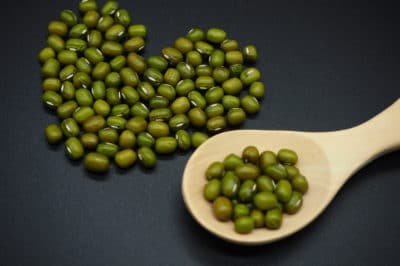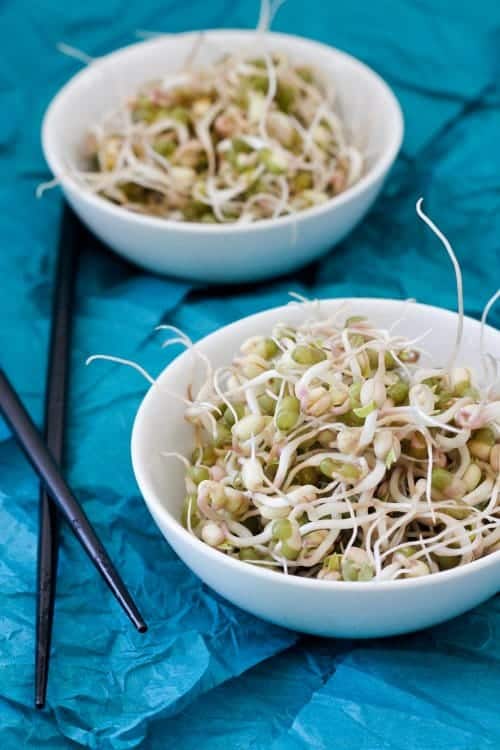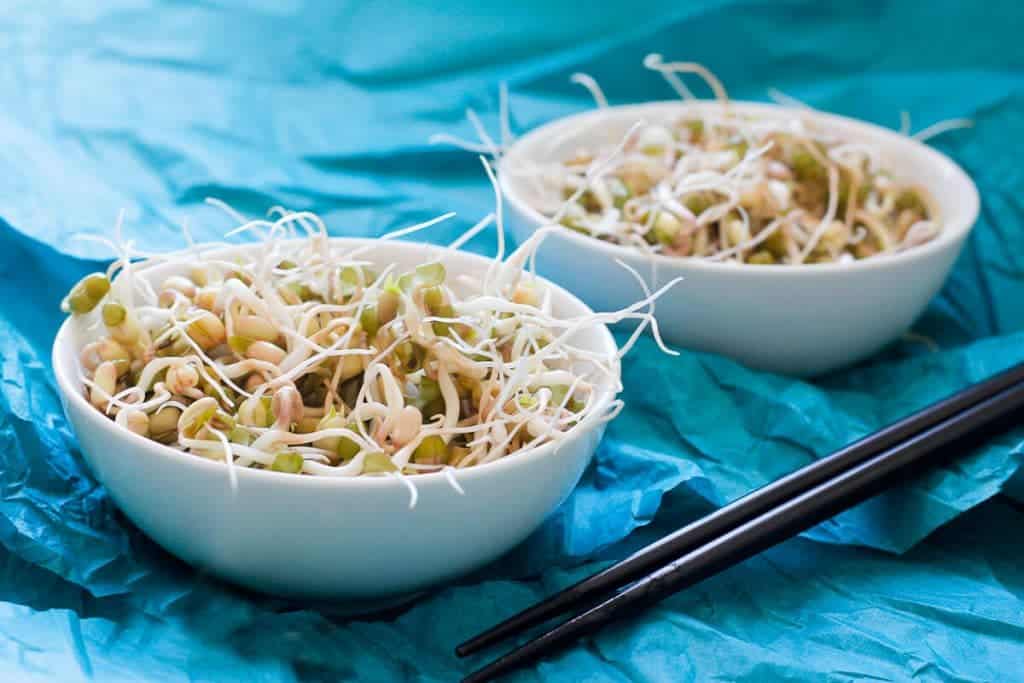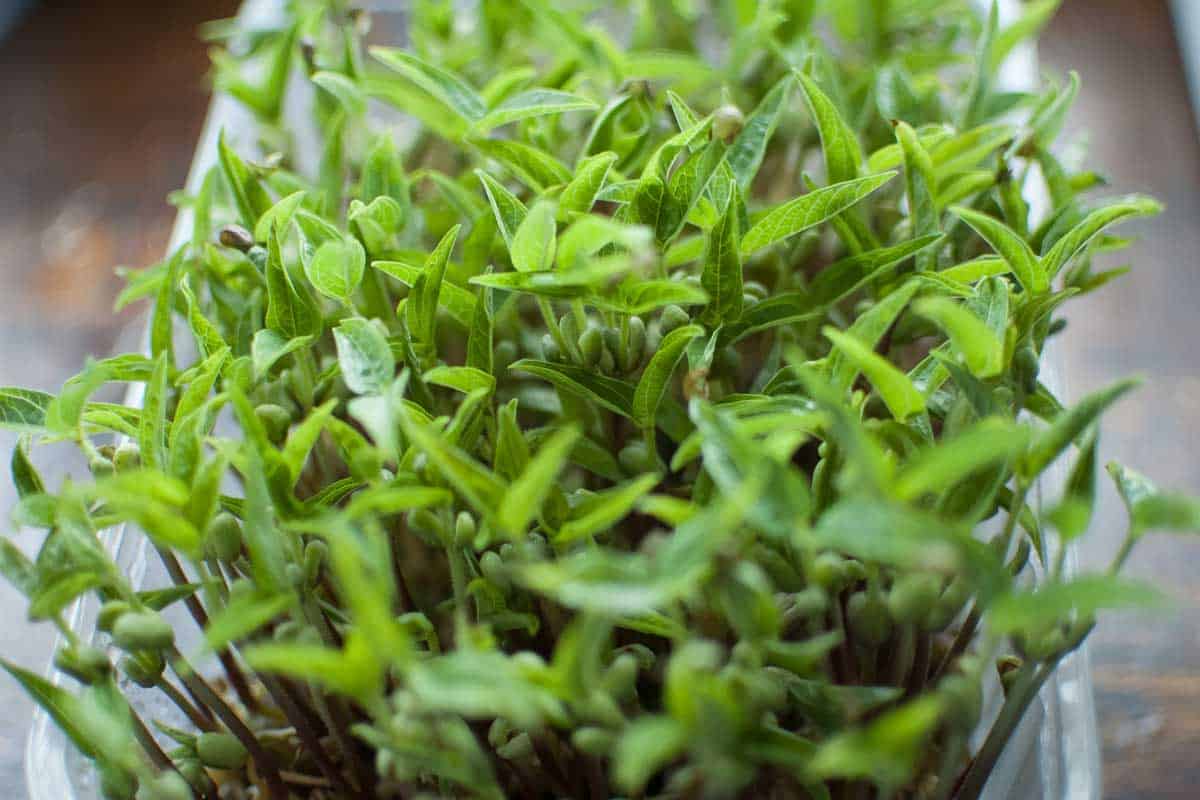How to grow mung beans
How to grow mung beans
How to Grow Mung Beans
The mung bean, probably native to India, has been grown since ancient times. It is used for human and livestock food as well for green manure. The dried beans can also be sprouted for culinary use. Although most mung beans used in the US are imported, you can easily grow your own.
About Mung Bean Plants
Mung beans are actually more closely related to cowpeas than the typical snap bean found in vegetable gardens. Although most mung beans are bush varieties, some may grow up to six feet tall. However, these “pole” beans are unlike typical pole beans, as the stalks are fairly stiff and will not twine around a pole or trellis. Tall mung beans will do better with some support.
Mung Bean Varieties
Although many seed catalogs will simply list them as mung beans, there are a number of varieties. They include:
Soil for Mung Beans
Mung beans prefer a fertile soil with good drainage – a sandy loam is ideal. In heavy clay soils that are easily waterlogged, the beans will perform poorly. Always use bean seed inoculant. The ideal soil pH is between 6.2 and 7.2. Micro-nutrient deficiencies may appear in more alkaline soils. You may need to add lime, phosphorus, potassium, calcium, magnesium and/or sulfur; do a soil test to make sure.
When to Plant Mung Beans
Like most legumes (favas are the only exception) mung beans are warm season plants. They need around 90 to 120 days of frost-free conditions to reach maturity. Plant about two or three weeks after the last expected frost date when the soil is thoroughly warm. You can also plant a short-season variety in early to mid-summer. However, shorter days may affect yield.
Planting the Seeds
Mung bean seeds are small and should be planted about one inch deep in soil with good moisture content. If you are dealing with drought conditions or have a dryland garden, you can plant up to three inches deep if the soil is loose. Seedlings are smaller than most beans and will have trouble breaking through a thick crust. Plant nine seeds per foot in rows 24 inches apart.
Harvesting Mung Beans
Mung beans are only used as dry beans to cook or sprout. Once at least two thirds of the plants in the patch have reached maturity, pull all the plants. Tie them in bunches and hang to dry in a warm, well-ventilated building until completely dry. Thresh the beans from the seed pods and spread on a flat surface until completely dry and hard. Store in sealed jars.
How to Grow Mung Bean Sprouts
Published: Mar 1, 2017 · Updated: Mar 15, 2021 · 19 Comments
Do you love adding sprouts to your soups, sandwiches, and salads? This easy food tutorial will show you How to Grow Mung Bean Sprouts!
First of all, what are mung bean sprouts?
Sprouts are formed when seeds start to ‘sprout’ into a full vegetable. Mung bean sprouts are… (wait for this)… sprouts from mung beans!
They’re a delicious, vegetarian source of plant-based protein.
You’ve probably eaten them (or at least seen them) if you’ve eaten Pad Thai or the Vietnamese soup Pho.
If you’ve seen an Asian or Asian-inspired recipe that calls for ‘bean sprouts,’ it probably meant mung bean sprouts.
These tasty veggies are crunchy, delicious, and incredibly easy to grow at home.
Bean Sprout Safety
I am not a doctor and if you’ve been advised by a doctor to avoid bean sprouts, please follow their advice, not mine.
When I was growing up, I loved adding bean sprouts to my sandwiches. I’d pile them high, and dig in. I loved the crunchy texture and the delicate flavors.
In the late 90s, however, bean sprouts began disappearing from grocery stores. Let’s call this, “The Case of the Disappearing Sprouts.”
I searched high and low, near and far– but could NOT find sprouts. Why not?
Sadly, bean sprouts are not always safe to eat, and major grocers pulled them off their shelves (although you can still find them in some international markets or health food stores).
What’s the problem?
If the seeds aren’t treated correctly, or the sprouts are grown incorrectly, you can end up getting sick and regretting your food choices. However, since I love the flavor, and a lot of meals seem incomplete without them, I wasn’t ready to give up on bean sprouts.
Can you solve all your bean sprout health woes by growing your own sprouts at home? No, because the problem can start with how the seed itself has been treated.
That’s why it’s extra important to buy mung beans that are SPECIFICALLY meant for sprouting or eating raw.
These seeds will be inspected more carefully with FDA regulations than seeds meant for planting.
How to Grow Mung Bean Sprouts
To grow mung bean sprouts, you need mung beans, a glass jar, and either a piece of cheesecloth with a rubber band or a sprouting jar lid. Your jar needs to be at least 16 ounces in size. (I use a standard Mason jar.)
Start by sanitizing your glass jar. I do this by putting it in the oven at 225 degrees for at least 20 minutes. Leave the jar in the oven until you’re ready to start.
Next, rinse your mung beans.
Set the beans in the jar, and add 2-3 times more water than beans.
Secure the cheesecloth over the top of your jar with a rubber band (or attach the sprouting jar lid), and set your jar in a dark space at room temperature (like in a cabinet).
Soak the seeds overnight (or for about 8-12 hours), and then drain the water.
Rinse the beans, drain all the water out, and store the jar on its side.
Rinse the beans twice a day for about 3 days, and then set the sprouted beans (still in the jar) where they can get some sunlight.
Leave them in the sun for about one day, and then refrigerate the sprouts and use them up within 3-5 days.
Tips for growing Mung Bean Sprouts
Once you’ve finished the final rinse, keep your sprouts as dry as possible.
Don’t wash them until right before you’re using them, and do not continue to rinse the sprouts each day.
If you live in a very cold or hot climate, and your home isn’t climate controlled, that will affect the growth time of your sprouts. It may be impossible to grow sprouts in very cold rooms.
Some sources recommend adding citric acid to your sprouting water to reduce the risk of bacterial growth. I haven’t tried this– but it is an option.
Have you tried growing your own sprouts? Let me know in the comments!
Quick Tip: If you love growing bean sprouts, you might also love this tutorial on How to Make Kombucha!
Mung Bean Plant: Popular Asian Beans
Table of Contents
Mung beans may not sound familiar to you, but you’ve probably had them if you’ve ever had bean sprouts. The bean sprouts you find at salad bars and in stir fry typically come from the mung bean plant in the United States.
Mung bean sprouts are one of the most common ways they’re eaten, but they can be utilized in other ways. They’re most popular in Asia, and they can be eaten savory or sweet, as sprouts or beans, and even as a paste.
While Americans in the United States may only know them as sprouts, you can grow mung beans yourself and learn all the delicious ways you can utilize every part of the plant. They grow similarly to many other beans such as green beans, so they aren’t difficult to care for. Let’s take a look at how to care for these plants so you can branch out and try something new.
Good Products At Amazon For Growing Mung Beans:
Quick Care Guide

| Common Name(s) | Mung bean, green gram, golden gram, moong, monggo, munggo, maash |
| Scientific Name | Vigna radiata |
| Days to Harvest | 100 days |
| Light | Full sun |
| Water | 2-3 inches per week |
| Soil | Well-drained sandy loam |
| Fertilizer | Optional, low nitrogen (5-10-10) |
| Pests | Aphids, bean beetles, bean weevils, mealybugs |
| Diseases | Anthracnose, bean blight, bean mosaic, bean rust |
All About Mung Beans
Vigna radiata, or the mung bean, has many names across the world. In international publications, you may see it listed as the green gram or golden gram. In Asian countries, you’re likely to see names such as moong, monggo, munggo, or maash.
The mung bean plant originated in India and has been used there since ancient times but is now popular in many Asian countries. Asia is responsible for growing most mung beans, but they’re also grown in Africa and South America. They’re also grown in the United States, with Oklahoma being the state that grows the most.
Mung bean plants are in the legume family and typically grow 2.5 feet (76 centimeters) tall, although some varieties can grow a bit taller. They grow pale yellow flowers at the top of the vine in clusters of up to fifteen. Yellowish-brown or black bean pods will develop from the flowers, which will be fuzzy when they’re mature. The seeds can be of different colors, including yellow, green, brown, or black. Like other legumes, mung beans produce their own nitrogen.
You can grow mung beans in a similar manner to other bush bean plants. The biggest difference is that the beans will stay on the plant longer than many other bean varieties. Growing mung beans requires patience, but the end product is so worth it!
Not only can you eat the beans, but the leaves and root tubers are also edible. In fact, the entire plant can be consumed, although parts of it (like the pods themselves) are not as palatable as the beans. The leaves can be too fibrous to enjoy fresh, so they’re typically cooked or used for cattle forage as an animal protein source. The tubers are generally only eaten in times of desperation, but their creamy white interior makes them pleasing enough to cook and eat.
Planting Mung Beans
When to Plant
Mung beans take about three months to grow from seed to maturity, so planting toward the end of spring is ideal. May is often an appropriate time to sow once it reaches 65°F (18.3°C) and stays above it. These are a warm-season crop, and the larger seeds will struggle to germinate if it’s too cold.
If you want a continual harvest once they’ve matured, plant seeds every two weeks.
Where to Plant
Growing mung beans is pretty easy because the mung bean seeds can be planted almost anywhere. They’re suitable for planting in the ground, in raised beds, and in containers, as long as they can receive at least six hours of sunlight.
Mung bean seeds shouldn’t be planted in rocky or weedy areas. The soil should be smooth and easy for roots to go through. The soil needs a pH level of 6.2-7.2. Avoid planting mung beans in areas where it won’t be easy to amend the soil as needed.
How to Plant
Planting mung beans is simple and begins with adding 1-2 inches of compost to the soil. Since mung beans are nitrogen-fixing, they won’t require much nitrogen fertilizer. A few inches of composted organic matter that is nutrient-rich should be enough to feed the entire plant throughout its lifespan.
To start to grow mung beans, plant seeds one inch deep into the soil and two inches away from each other. The rows should be 30-36 inches apart. Add a bean inoculant into the hole or apply it to the seed directly. Inoculants are optional, but they help the beans create nitrogen more efficiently.
Mung beans prefer to be sown directly rather than transplanted, but it’s still possible to grow from transplants. Carefully place the transplants into holes that are big enough to fit the root ball. The transplants should have at least six inches between them.
Let’s take a look at how to care for your growing mung beans so you can have a bountiful harvest in three months.
Sun and Temperature
Like most other beans, mung beans require full sun, which is at least six hours of direct light each day. As mentioned before, your growing mung beans are a warm-season crop and they’ll perform best in the right weather conditions.
The ideal USDA hardiness zones for mung beans are 10-12, but you can grow them in cooler regions as long as they stay within the ideal temperature range of 69-96°F (21-36°C) during its growing season. Mung beans can tolerate temperatures as high as 104°F (40°C) and as low as 46°F (8°C). They’re not frost-tolerant, so anything below that will cause damage or kill them.
Water and Humidity
You need water for growing mung beans, but fortunately, they have moderate drought tolerance to help you through those dry spells. A young mung bean will need more water than a mature plant.
When you water your established and growing mung beans, water at the base of the plant to prevent moisture on the leaves. Wet leaves can attract fungal disease. Soaker hoses are an excellent choice here.
Vigna radiata should receive 2-3 inches of water per week, which will even out to watering a few times each week. You don’t have to water as often in cool weather or in the rainy season. Make sure the soil stays moist, but avoid soggy soil at all costs.
Mung beans prefer sandy loam and loamy soil conditions that are rich with plenty of organic matter such as composted plant waste or manures. It shouldn’t have large rocks or weeds. The soil should be well-draining, so water can’t puddle.
The ideal pH range for mung beans is 6.2-7.2.
Fertilizing
When it comes to fertilizing, you shouldn’t have to do so if you added good compost to the soil. But, if your growing mung beans could use a boost, use something that’s low in nitrogen. A 5-10-10 fertilizer will work well.
Nitrogen aids with growing leaves, so add just a bit at the beginning for a little boost. Too much will cause the plant to focus on foliage production rather than the mung beans, which is why we suggest using as little nitrogen as possible once the vines are established.
Pruning
Pruning mung beans is unnecessary. You can prune the plants to remove dying or damaged leaves, but other than that, the plants don’t require it.
Propagation
Mung beans are propagated only by seed. Soak the seeds in warm water for up to twelve hours. Then plant the seeds, and you’ll have mung bean sprouts soon.
Harvesting and Storing
Legumes are perhaps one of the most appreciated crop types because they have a long shelf life and make the perfect hot meal on a cold day. If you don’t want to eat all your mung beans at the end of summer, you can store them for up to a few years. No rush!
Harvesting
You’ll know your mung beans are ready to harvest when pods are about 5 inches (12 centimeters) long. They should be a yellowish-brown or black color, and the pods will be fuzzy. If the pods are still green, they’re not ready yet.
Not every mung bean will be ready simultaneously, but you can harvest when about 60% of them are fully mature. To harvest, pull up the entire vine and hang it upside down in a cool, dry place. A garage or shed will be the perfect place.
Place newspapers or fabric underneath the vine to catch the mung beans as they fall off. Since some of the pods are still maturing, it should take a few weeks for this process to be complete.
Storing
To store fresh mung beans without drying them, place them in an airtight container and keep them for 2-3 days. Keep a clean paper towel in the container to soak up moisture. Excess moisture will cause the beans to go bad quickly.
To store them as a dry bean, once all the pods are dried after hanging upside down (as described previously), remove the beans from the pods and lay them out on paper towels or newspapers to dry out completely.
Once they’re completely dry, store them in a plastic bag or airtight container like a tight-fitting glass canister. They should last for a few years, allowing you to save for winter or as an emergency food supply.
You can store dry beans in the freezer to make them last even longer. This will prevent an insect infestation from occurring.
Troubleshooting
Mung beans may be easy to grow, but that doesn’t mean they’re free from problems. There are only a few pests and diseases to look out for, and prevention will be the best way to battle them.
Growing Problems
One problem you may have with mung beans is too much nitrogen. Beans of any kind may fail to set flowers if they receive too much nitrogen when they’re young. Another sign is if vines have too many leaves for their stems. The leaves become too heavy and cause the stems to break. If your beans seem to have too much nitrogen, add several inches of compost to round out the nutrients it’s receiving.
Pests
Aphids and mealybugs are two pests that suck out the sap of plants that may make their home on your mung beans. As they feed, leaves will become distorted and may shrivel up. Covering your vines with row covers is a good preventative measure for most plants. Ladybugs will eat aphids, or use neem oil, insecticidal soap, or pyrethrin to kill both aphids and mealybugs.
Another couple of pests are bean beetles and bean weevils, both of which will eat leaves. You can use pyrethrin to eliminate the insect infestation, but you’ll need to spray the growing mung beans regularly to catch each life cycle. Preventative measures you can take include crop rotation, removing dead matter and other debris at the end of the season, and avoiding overwatering.
Diseases
Bean rust is a fungal disease that can infect any type of bean. It causes reddish-brown patches with yellow halos, deformed bean pods, and wilted foliage. Wet conditions, including humid weather, can cause this to spread.
Another fungal disease is anthracnose, which is common in cool, wet spring weather. Remove all the infected parts of the plant and treat with neem oil or copper fungicide.
The bean mosaic viruses are spread by aphids. Each will have different symptoms, such as yellowing leaves, black spots, or stunted growth. These viruses can’t be cured, and you’ll need to remove and dispose of your beans. Avoid composting these to prevent further spread of the virus.
Bean blight can be spread by beetles, whiteflies, or wet leaves. A copper-based fungicide can prevent the spread.
Frequently Asked Questions
Q: How long does it take for mung beans to grow?
A: It takes about three months (100 days) for a mung bean to reach maturity.
Q: Can you eat mung bean plant?
A: You can eat the beans, leaves, and tubers, although the leaves and tubers should be cooked first since they can be unpleasant to eat.
Q: Where can mung beans be grown?
A: Mung beans need to be grown in a sunny location that receives at least six hours of direct sun. They can be grown in containers, raised beds, or directly in the ground.
Growing Mung Beans in Pots | How to Grow Mung Beans
Growing Mung Beans in Pots is an inexpensive way to add essential nutrients to your table! Here is all you need to know to grow this powerhouse of proteins!
Easy to grow and full of proteins, mung beans are a great option for vegans. Growing Mung Beans in Pots is the best way to relish their taste when they’re freshly harvested from containers! Add to your salads after sauteeing in olive oil or roast in butter after sprouting, you can enjoy them fresh in both ways!
Botanical Name: Vigna radiata
Common Names: Mung bean, Golden gram, Jerusalem pea, Moong bean, Green gram, Celera bean, Mungbean, Mungbohne, Jerusalembohne, Frijol mungo, Judía mungo, Poroto chino
Check out our article on best types of beans you can grow here
Planting Time
Native to India and southeast Aisa, it does well in warm temperatures. Spring and Summer is the best time to plant mung beans.
Growing Mung Beans in Pots
Growing mung beans in pots is a straight and easy process. Just plant seeds half an inch deep and space them 2 inches apart. You can also grow these beans with broccoli, cabbage, cauliflower, carrots, kale, celery, and peas as they are some of the best companion plants.
Choosing a Container
Before choosing a pot, you need to know that the plant has a long root system. Choosing a container that accommodates it well will do the trick. A 4-6 inches pot will be a great starting size for varieties like Berken and Texsprout.
Requirements for Growing Mung Beans in Pots
Location
Being a warm-season crop, they do best in brightly lit areas. Placing the pot where it gets 6-8 hours of sunlight will result in thicker and fuller growth of beans.
If you want to see your plants thrive, use well-draining soil. Sandy, loam soils with a pH of 6.2 and 7.2 are going to serve best.
Watering
Water moderately and keep the soil moist. As the beans grow best with average watering, overwatering the plants may result in a poor crop. Also, avoid wetting the foliage as it may attract fungal diseases.
Taking Care of Mung Beans in Pots
Fertilizing
Like other legumes, mung beans can take care of their nitrogen requirements. You just have to supplement phosphorus and potassium to the plant. A 5-10-10 blend will work fine. Do refer the label for dosage and intervals.
Pests and Diseases
The plant may be subjected to attacks from thrips, chickpea leafminers, pod borers, grasshoppers, and aphids. Using insecticidal soap will take care of them.
Ascochyta blight, root rot, and stem rot are common diseases that can be prevented by avoiding overwatering and wetting the foliage.
Harvesting and Storage
The plant will be ready to harvest in 90-110 days or when it reaches a height of 16-20 inches. Take out the entire plant and hang it upside down in a garage or shed to dry. Once dry, you can collect the beans and store them in airtight containers.
How To Grow Mung Beans Indoors
Disclosure: We may get commissions for purchases made through links in this post.

To grow full-sized plants in soil:
To sprout mung beans indoors:
Now that you have a quick overview of how to grow or sprout mung beans, you probably have lots of other questions. We’ll explain each step of the process in more detail and also answer a few of the most frequently asked questions. So, let’s get started!
How To Grow Mung Beans Indoors
Choose The Right Pot
One of the most important parts of growing a mung bean plant indoors is selecting a pot that is big enough to accommodate the plant’s long root system. Your pot should be at least 5” deep. Deeper would be even better since it would give your mung bean plant plenty of room to spread out as it grows without needing to transplant.
The two largest pots in this set of three terra cotta planters are the perfect size for growing mung beans.
Select The Best Soil And Fertilizer
Although this soil is intended for cacti and succulents, its sandy, loamy formulation is also perfect for mung beans.
If you prefer growing organic plants, try this all-natural, organic soil.
Little Water, Lots Of Sun
Since mung beans developed in a hot, dry environment, they only need a few deep watering sessions during their growing season. If you plant the seeds in moist soil, you won’t need to water again for another 20 days. Less water means that the plants will be forced to focus on seed production, which is great if you want to encourage a large crop.
The long, narrow nozzle on this watering can makes it easy to pour water directly on the roots of the plant, allowing you to give it a long, direct soak.
Alternatively, you could supplement the natural light with a grow lamp, especially if you’re growing mung beans during the winter.
The long, bendable necks on these grow lights make it easy to adjust the height of the lamp as the mung beans grow.
Harvest
To harvest your mung beans, pull the entire plant out of the ground after two-thirds of the pods are mature. Tie them in bunches and hang them upside down to allow the bean pods to dry.
After the pods are dry, shell them and allow the beans to dry completely spread out on a sheet of paper. It’s important to make sure the beans are completely dry since any amount of moisture could cause mold.
How To Sprout Mung Beans Indoors
Soak Thoroughly
Transfer To A Sprouting Jar
Drain and rinse your beans, drain them again, and then put them in a sprouting jar. You could also use a regular glass with a piece of cheesecloth secured over the mouth with a rubber band.
This sprouting set even includes a seed blend, if you enjoy your mung bean sprouts and want to try something else, too!
If you already have mason jars, you can also just order sprouting jar lids.
Rinse, Drain, Harvest
Are Mung Beans Easy To Grow?
Mung beans are known for being easy to grow, and they sprout both indoors and outside. You can grow regular plants or sprout them so you have a supply of delicious plant sprouts that can be used on salads and sandwiches.
Although it is possible to grow mung bean plants inside, they grow better outside since they need a lot of light. If you’re looking for the easiest indoor option, sprouting is your best choice.
If you’re looking for other vegetables that are easy to grow indoors, check out our article Can You Grow Vegetables Indoors All Year Round?
How Long Do Mung Beans Take To Grow?
Can Mung Beans Grow Without Soil?
Sort of! While a full mung bean plant needs to be supported by soil, you can grow mung bean sprouts in a glass jar after soaking them in water.
Saturday 20th of November 2021
Tried a few times putting mung in with the microgreen flats, easier to pt everything through the same microgreen process; doesn’t work well with mung. By full harvest of everything else 10 days the mung is still just leafless sprouts. I think mung is meant to either be jar sprouted and eaten, or for green leaf grown in dryer conditions.
Monday 12th of April 2021
Hello, can I ask what is the ideal number of seeds to plant in one pot? Or how many seeds should I plant in one pot?
Tuesday 9th of November 2021
There is no way to know how many seeds you should plant in one pot because it varies on the spacing and size of the pot.







